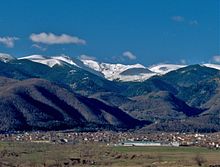Massif
This article needs additional citations for verification. (October 2010) |
In geology, a massif ( /mæˈsiːf/ or /ˈmæsɪf/) is a section of a planet's crust that is demarcated by faults or flexures. In the movement of the crust, a massif tends to retain its internal structure while being displaced as a whole. The term also refers to a group of mountains formed by such a structure.
In mountaineering and climbing literature, a massif is frequently used to denote the main mass of an individual mountain. The massif is a smaller structural unit of the crust than a tectonic plate and is considered the fourth largest driving force in geomorphology.[1]
The word is taken from French (in which the word also means "massive"), where it is used to refer to a large mountain mass or compact group of connected mountains forming an independent portion of a range. One of the most notable European examples of a massif is the Massif Central of the Auvergne region of France.
The Face on Mars is an example of an extraterrestrial massif.[2]
Massifs may also form underwater, as with the Atlantis Massif.[3]
List of massifs
Africa
- Adrar des Ifoghas – Mali
- Aïr Massif – Niger
- Benna Massif – Guinea
- Bongo Massif – Central African Republic
- Ennedi Plateau - Chad
- Kilimanjaro Massif – border of Kenya and Tanzania
- Oban Massif – Nigeria
- Marojejy Massif – Madagascar
- Mulanje Massif – Malawi
- Virunga Massif – border shared by Uganda, Rwanda and DR Congo
- Waterberg Biosphere – South Africa
Antarctica
Asia
- Annapurna – Nepal
- Chu Pong Massif – Vietnam
- Dhaulagiri – Nepal
- Gasherbrum – Pakistan
- Hazaran – Iran
- Kholeno – Iran
- Kangchenjunga – Nepal
- Knuckles Massif – Sri Lanka
- Kondyor Massif – Russia
- Kugitangtau Ridge – Turkmenistan
- Logar ultrabasite massif – Logar Province, Afghanistan
- Mount Ararat – Turkey
- Mount Everest massif (including Lhotse) – border of Nepal and Tibet (China)
- Mount Kinabalu – Malaysia
- Mount Tomuraushi – Japan
- Nanga Parbat – Pakistan
- Nun Kun – India
- Panchchuli – India
- Shillong – Meghalaya, India
- Bundelkhand Massif - [[U.P.],[M.P.]], India
Europe


- Alpilles – France
- Aravis Range – France
- Ardennes Massif – France/Belgium/Luxembourg
- Areskutan – Sweden
- Armorican Massif – Brittany, France
- Bauges Massif – France
- Beaufortain Massif – France
- Ben Nevis massif – Scotland, United Kingdom
- Bohemian Massif – Czech Republic
- Bornes Massif – France
- Calanques Massif
- Ceahlău Massif – Romania
- Cerces Massif
- Chablais Massif – France
- Chartreuse Massif – France
- Cornubian Massif – United Kingdom
- Dévoluy Massif – France
- Massif des Écrins – France
- Gotthard Massif – Switzerland
- Jungfrau Massif – Switzerland
- Jura Mountains – France
- Lauzière massif
- L'Esterel Massif
- Long Mynd – England, United Kingdom
- Lubéron – France
- Massif Central – France
- Massiccio del Matese - Italy
- Mangerton Mountain – Ireland
- Mercantour – France
- Montgris – Spain
- Montserrat – Spain
- Mont Blanc massif – Italy/France/Switzerland
- Massiccio del Pollino - Italy
- Rila - Rhodope Massif – Bulgaria/Greece
- Sila Massif – Italy
- Snowdon Massif – Wales, United Kingdom
- Taillefer Massif – France
- Troodos – Cyprus
- Untersberg – Germany/Austria
- Queyras Massif – France
- Vanoise Massif – France
- Vercors Plateau – France
- Vitosha Massif – Bulgaria
- Vosges Mountains – France
North America
- Adirondack Massif – New York, USA
- Mount Cayley massif – British Columbia, Canada
- Laurentian Massif – Quebec, Canada
- Le Massif – Canada
- Denali – Alaska, USA
- Level Mountain – Canada
- Mount Edziza – Canada
- Mount Juneau – Alaska, USA
- Mount Le Conte – Tennessee, USA
- Mount Logan – Yukon, Canada
- Mount Meager massif – Canada
- Mount Septimus – Canada
- Mount Shuksan – Washington, USA
- Teton Range – Wyoming, USA
Oceania
Caribbean
South America
- Brasilia Massif – Brazil, Argentina, Paraguay, Uruguay.
- Neblina massif – Venezuela–Brazil border
- Colombian Massif – Colombia
- North Patagonian Massif – Argentina
- Deseado Massif – Argentina
Submerged
- Atlantis Massif – part of the Mid-Atlantic Ridge in the North Atlantic Ocean
- Tamu Massif — the largest volcano on Earth
References
- ^ Allen, 2008, Time scales of tectonic landscapes and their sediment routing systems, Geol. Soc. Lon. Sp. Pub., v. 296, p. 7–28.
- ^ Britt, Robert Roy (2006-09-21). "Mars Face Makeover: Controversial Formation Observed from New Angles". Space.com. Retrieved 2009-05-04.
- ^ Blackman, Donna (2002). "Geology of the Atlantis Massif (Mid-Atlantic Ridge, 30°N): Implications for the evolution of an ultramafic oceanic core complex". Marine Geophysical Researches. 23 (5): 443–469. Bibcode:2002MarGR..23..443B. doi:10.1023/b:mari.0000018232.14085.75.
- ^ "The Sydney Morning Herald, November 6, 2009". 2009-11-06.

